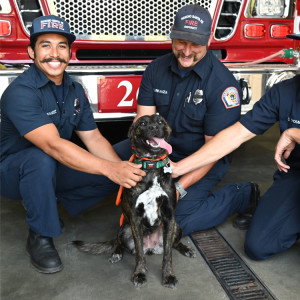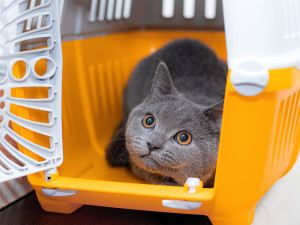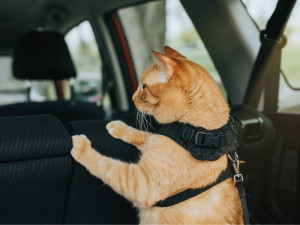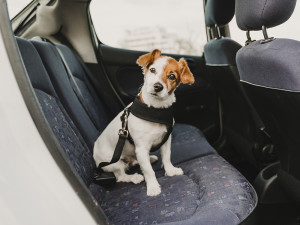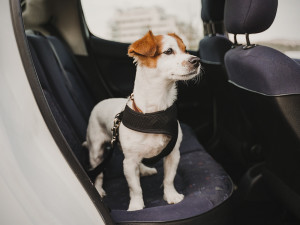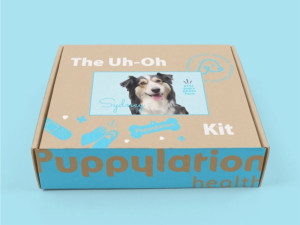Wildfires Are More Common Now. Here’s How You Can Protect Your Pets
Wildfire season is here. Take these steps to protect your pets.
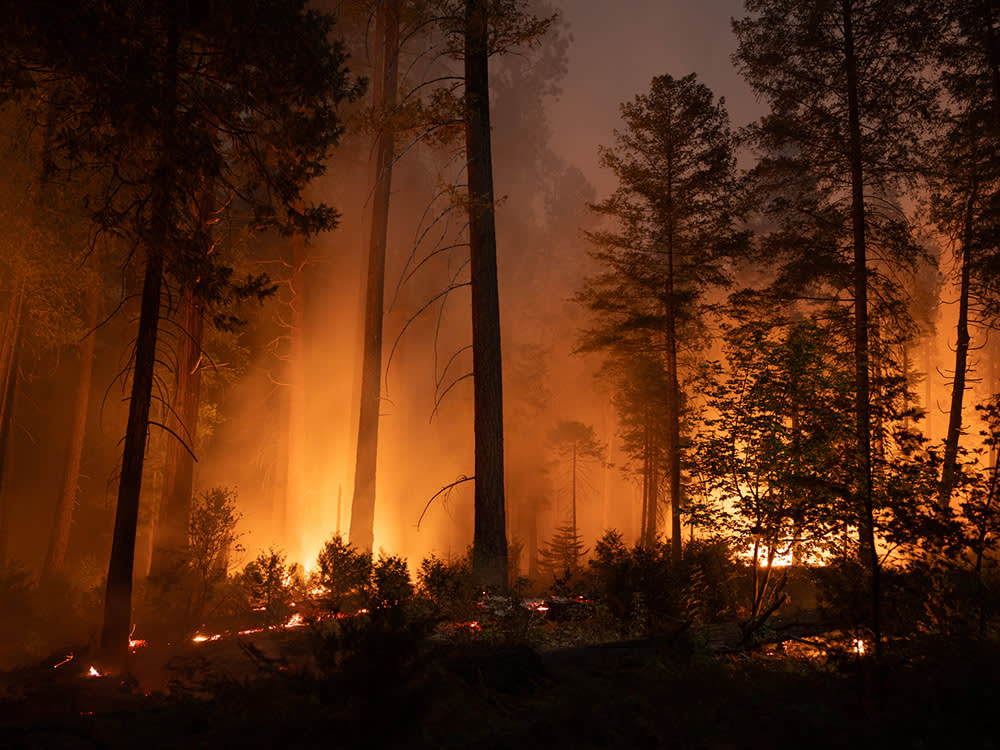
share article
Last summer, as Canadian wildfiresopens in a new tab blew through the Eastern United States, New York City residents posted images opens in a new tab of a yellow-orange sky shrouding the skyline. Per a reading from AirNowopens in a new tab, the air quality in Syracuse, New York surpassed 400, which is well into “hazardous” territory on the website’s meter. NYC was in similar territory. Brooklyn recorded a 413 on the air quality scale and Queens was at a 400, Gov. Kathy Hocul said at a news conferenceopens in a new tab. Other areas of the East Coast were feeling the effects, too. The Pennsylvania Department of Environmental Protection tweeted that the entire stateopens in a new tab is under a “code red” and encouraged residents to limit their outdoor activities. When a natural disasteropens in a new tab like this one strikes, the first thought on a pet parent’s mind is, What do I do to protect my pets?
Unfortunately, this is a question that you might have to be asking a lot more throughout the year — not just this week. Just a couple of decades ago, wildfire season spanned four months, from late summer to early fall. It took place primarily in Western states, such as California and Oregon. But (no) thanks to the worsening effects of climate change, the very idea of a “wildfire season” could soon be overtaken by the “fire year,” according to the USDA Forest Serviceopens in a new tab.
According to recent modeling by First Street Foundationopens in a new tab, a nonprofit that maps climate risks, even eastern states thousands of miles away from hotspots are facing an increased chance of wildfires. So, here’s how to be prepared for a wildfire (and the resulting smoke).
Sign up for alerts.
First and foremost, sign up for emergency alerts. “There are guidelines set by the county or state for your area in terms of what your alert status might be,” says veterinarian and Collective member Dr. John Iovinoopens in a new tab, who is based in Oregon.
There are several ways that you can do this. The FEMA appopens in a new tab gives real-time updates from the National Weather Service. Find your local emergency-alert system by typing your town, city, or county’s name and “alerts” into a search engine. If you live in a hotspot for blazes, then you might be able to sign up for an alert just for wildfires. Watch for any orders to evacuate. “It’s important to pay attention to that so you have an idea of when to act and have an emergency bag in case you need to evacuate,” Dr. Iovino adds.
If you can, place a pet-rescue alert sticker on your door or front window, somewhere visible to rescue workers in the event that you’re unable to get your pets out of the house. The American Society for the Prevention of Cruelty to Animals (ASPCA) will send you one for freeopens in a new tab. Ensuring that your pet is microchippedopens in a new tab could help reunite you in the event that you’re separated during a disaster.
Develop an escape plan.
Realistically, you should be prepared for wildfires long before one threatens your home. Make sure everyone in your home knows the escape plan and keep an emergency kit in a location that everyone knows. (You can find more emergency preparedness tips from the federal government’s Ready campaignopens in a new tab.) You’re going to want to think on the fly as little as possible, especially if your stressed-out self is also in charge of some even-more-stressed-out animalsopens in a new tab.
Pet parents should have a separate plan for their animals. Decide who will be responsible for seeing them to safety in case of an evacuation and have an emergency kit at the ready. Whoever takes charge here should know all of their pets’ secret hiding places.
Pack a pet emergency kit.
Just like your own go-bag, your pet’s emergency kitopens in a new tab should be packed with necessities and should be stored close to the door that you plan to use as your main escape route:
Between three to seven days’ worth of foodopens in a new tab (rotate every two months)
At least a week’s worth of bottled water per pet (replace every two months)
Treats
Pet first-aid kit
Medication
Can opener for wet food
Toys and blankets, if possible
Leashes and harnessesopens in a new tab, cat carriersopens in a new tab, dog cratesopens in a new tab
Know where you can stay.
You should have a general idea of where your pet is going to stay, and have several backup plans. Research the local hotels and emergency shelters so you know which ones are pet-friendly. Ask your local animal shelter if they provide emergency foster care or boarding. If you have friends and family outside of the immediate area, ask if they could pet-sit for you while things calm down.
Keep an eye on air quality and your pets’ breathing.
Even if you don’t have to evacuate, you should pay attention to the air quality alerts in your area. One of the many unfortunate side-effects of a wildfire is smoke, which can lead to eye and respiratory tract infections in both humans and animals as well as more serious conditions, such as reduced lung function or premature death. So, sign up for alerts via AirNowopens in a new tab, or use the local equivalent.
If the alert system is telling you to stay inside, then your pet should, too. Shut all of the windows and if you have an air conditioner, run it to help filter out ash and particle matter that might have gotten into your home. Keep your pet’s walk short and wipe them down as soon as they’re indoors again, paying special mind to their nose and eyes.
Keep an eye on your dog for signs of any respiratory stress or eye irritation. There are such things as canine air pollution masksopens in a new tab, which go over your dog’s muzzle and are meant to filter out ash. But unless you train your dog from a very young age, they’ll most likely try to remove the mask, especially during a stressful situation. “Save them for extreme situations only, where humans would also put on a mask,” Dr. Iovino says.
Puppies, senior pups, dogs with asthma, and brachycephalic breedsopens in a new tab, such as Pugs, Boxers, and Shih Tzus have a bigger risk of being affected by smoke inhalation. Get in touch with your vet if your animals exhibit any of the following signs:
Difficulty breathing (including increased noise when breathing and open-mouthed breathing)
Inflammation of the throat or mouth
Eye irritation, very watery eyes
Asthma-like symptoms
Fatigue
Reduced appetite or thirst
Disorientation
“If you can, check your cat or dog’s tongue or gums. They should usually be pink, which is a sign that they’re getting enough air,” Dr. Iovino says. If you see blue or purple, you should seek help for your pet immediately.
The bottom line: be prepared.
Wildfire season can be stressful, especially combined with the ongoing news that they’re only getting worse. The best thing that you can do for yourself and your pets, is to be prepared for an emergency.

Kat L. Smith
Kat L. Smith is a writer and editor based in Queens, New York. They have written for LIVEKINDLY about a wide range of topics related to sustainability, lifestyle, house plant care, and food. They share their apartment with their adopted dog, Layla, and Vivi, a one-eared cat.

Hilary Weaver
Hilary Weaver is the senior editor at The Wildest. She has previously been an editor at The Spruce Pets, ELLE, and The Cut. She was a staff writer at Vanity Fair from 2016 to 2019, and her work has been featured in Esquire, Refinery 29, BuzzFeed, Parade, and more. She lives with her herding pups, Georgie and Charlie.
Related articles
![Cat standing up in the back of a car]() opens in a new tab
opens in a new tabHow to Travel With a Cat (Without a Scratch)
Everything you need to bring your kitty home for the holidays, from an in-cabin carrier to calming products to a portable litter box.
![Dog seat-belted in a car]() opens in a new tab
opens in a new tab19 of the Best Car Travel Gear for Dogs
All the essentials you need to hit the road with your co-pilot, from dog seatbelts to crash-tested carriers.
![Jack Russell dog in backseat of s car wearing a safety harness and seat belt]() opens in a new tab
opens in a new tabHow to Keep Your Dog Safe in the Car
Hitting the road with your dog? Make sure they're safe with this helpful advice.
![uh-oh kit for dogs]() opens in a new tab
opens in a new tabYou Need This Customizable, Vet-Designed First Aid Kit for Dogs
Just in case.
![A tan and white at in a white litter box placed beneath a white, rectangular Petkit Air Purifier affixed to the wall]() opens in a new tab
opens in a new tabPetkit’s Air Purifier Transformed the Way My Home Smells
The Petkit Pura Air uses an advanced filtration system to keep pet-friendly homes odorless.
